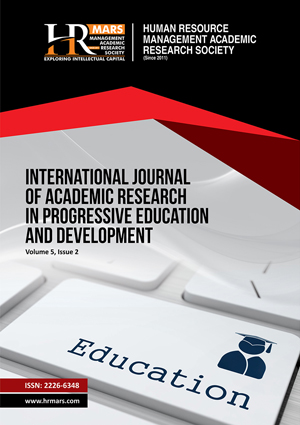
ISSN: 2226-6348
Open access
Artificial Intelligence (AI) can be defined as a system that demonstrates intelligence by analyzing its environment and independently taking actions to achieve specific objectives. This study aims to identify the level of skills, usage, and the impact of using Artificial Intelligence (AI) technology among teachers in implementing Information and Communication Technology (ICT)-based education for the RBT subject in primary schools within the Petaling Perdana District. It also examines the relationships between skill levels, usage, and the impact of AI utilization. This survey-based study involved 100 respondents and utilized a Likert-scale questionnaire consisting of four main sections: demographics, AI usage skills, level of AI usage, and the impact of AI usage. Data analysis was conducted using descriptive statistics and Spearman’s Rank test. The findings indicate that teachers’ skill levels are high (mean=3.91), their level of AI usage is moderate (mean=3.55), and the impact of AI usage is high (mean=3.77). The Spearman’s Rank test found significant relationships between skill levels and the impact of AI usage, as well as between the level of usage and its impact on teachers' engagement with AI technology. These findings suggest several initiatives to ensure the full implementation of AI usage, including organizing incentive training programs, developing supportive technological infrastructure, and raising awareness of AI technology utilization. This study supports the view that AI integration has the potential to improve the quality of education through data analysis, automation, and enhanced learning effectiveness.
Al-Midlij, N., & Alotaibi, N. (2023). Advantages of Using Artificial Intelligence in Teaching English as a Second Language Public Authority for Applied Education and Training Language Centre. Multi-Knowledge Electronic Comprehensive Journal For Education & Science Publications ( MECSJ ), 68, 1–13.
Anthropic. (2021). Using AI safely to improve education at scale. Anthropic.
Bagir, M., Karakoyun, G. O., & Asilturk, E. (2022). Views of Science Teachers on the Use ofArtificial Intelligence in Education. International Online Journal of Educational Sciences, 14(5), 1223–1234.
Basweti, E. A., Kibinge, J. M., & Oboko, R. (2022). Use of AI-based virtual lab simulations to enhance chemistry practicals learning during Covid-19 restrictions in Kenyan universities. Journal of ICT Education, 9, 1-21.
Borham, S. R., Ramli, S., & Ghani, M. T. A. (2022). Integrasi konsep kecerdasan buatan dalam reka bentuk kit E-Muhadathah untuk bukan penutur Arab: Integration concept of artificial intelligence in the design of E-Muhadathah kit for non-Arabic speakers. Journal of ICT in Education, 9(3), 1-10.
Ghazali, R. C., & Abd Halim, N. D. (2022). Kesediaan Pelajar Sekolah Menengah Terhadap Penggunaan Aplikasi Google Classroom dalam Pembelajaran Norma Baru. Innovative Teaching and Learning Journal, 6(1), 16-31.
Kaban, A. (2023). Artificial Intelligence in Education: A Science Mapping Approach. International Journal of Education in Mathematics, Science and Technology, 11(4), 844 861.
Kucuk, T. (2023). AI Integrated Grammar Teaching in Language Preparatory School. International Journal of Social Sciences & Educational Studies, 11(1), 1–17.
Milicevic, N., Kalas, B., Djokic, N., Malcic, B., & Djokic, I. (2024). Students’ Intention toward Artificial Intelligence in the Context of Digital Transformation. Sustainability (2071 1050), 16(9), 3554.
Mørchid, M., Morgan, B., Obregon, M., Elsayed, T., & Maghouii, B. (2020). A personalized educational chatbot using dynamic student modeling. International Educational Data Mining Society.
Niam, T. K., & Nordin, Z. S. (2024). Pengaruh Penggunaan Kecerdasan Buatan (AI) dalam Pengajaran dan Pembelajaran Terbeza Guru Bahasa Melayu di Sarawak, Malaysia. Jurnal Dunia Pendidikan, 6(1), 617-625.
Pathak, A., Derr, R., Rathore, S., & Parekh, K. (2020). Artificial intelligence in education: Applications, challenges and implications. Proceedings of the Fifth International Conference on Technology in Education.
Putri, A. N., & Hasan, M. A. K. (2023). Penerapan kecerdasan buatan sebagai media pembelajaran bahasa arab di era society 5.0. Tarling: Journal of Language Education, 7(1), 69-80.
Sahara, S., Ilmi, M., & Silalahi, R. Y. B. (2023). Pendampingan Edukasi Cerdas Menyikapi Tren AI (Artifial Intelligence) dalam Dunia Pendidikan. Jurnal Penelitian dan Pengabdian Masyarakat, 1(4), 354-364.
Salam, M. Y., Mahayuni, Taman, M., & Mudinillah, A. (2023). Using Artificial Intelligence for Education in the Education 5.0 Era to Improve Reading Skills. Arabiyat: Journal of Arabic Education & Arabic Studies / Jurnal Pendidikan Bahasa Arab Dan Kebahasaaraban, 10(2), 149–162.
Sava?, E. (2021). Potansiyel ö?retim teknolojileri: Yapay zeka [Potential teaching technologies: Artificial intelligence]. Journal of Education and Future, 23, 67-82.
Wojciechowski, A., & Korjonen-Kuusipuro, K. (2023). How Artificial Intelligence Affects \ Education? Human Technology, 19(3), 302–306.
Zawacki-Richter, O., Bai, J. Y. H., Lee, K., Slagter van Tryon, P. J., & Prinsloo, P. (2024). New advances in artificial intelligence applications in higher education? International Journal of Educational Technology in Higher Education, 21(1), 1–4.
Razak, N., & Norman, H. (2025). The Use of Artificial Intelligence (AI) among Teachers in Implementing ICT-Based Education for the RBT Subject. International Journal of Academic Research in Progressive Education and Development, 14(2), 1085–1109.
Copyright: © 2025 The Author(s)
Published by HRMARS (www.hrmars.com)
This article is published under the Creative Commons Attribution (CC BY 4.0) license. Anyone may reproduce, distribute, translate and create derivative works of this article (for both commercial and non-commercial purposes), subject to full attribution to the original publication and authors. The full terms of this license may be seen at: http://creativecommons.org/licences/by/4.0/legalcode